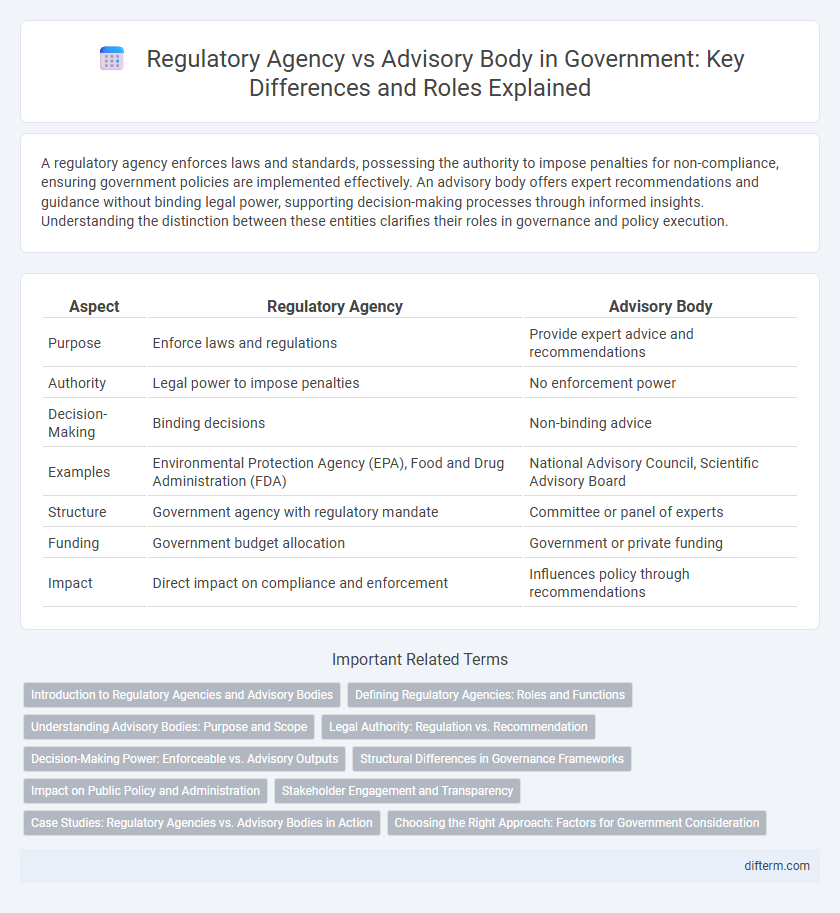A regulatory agency enforces laws and standards, possessing the authority to impose penalties for non-compliance, ensuring government policies are implemented effectively. An advisory body offers expert recommendations and guidance without binding legal power, supporting decision-making processes through informed insights. Understanding the distinction between these entities clarifies their roles in governance and policy execution.
Table of Comparison
| Aspect | Regulatory Agency | Advisory Body |
|---|---|---|
| Purpose | Enforce laws and regulations | Provide expert advice and recommendations |
| Authority | Legal power to impose penalties | No enforcement power |
| Decision-Making | Binding decisions | Non-binding advice |
| Examples | Environmental Protection Agency (EPA), Food and Drug Administration (FDA) | National Advisory Council, Scientific Advisory Board |
| Structure | Government agency with regulatory mandate | Committee or panel of experts |
| Funding | Government budget allocation | Government or private funding |
| Impact | Direct impact on compliance and enforcement | Influences policy through recommendations |
Introduction to Regulatory Agencies and Advisory Bodies
Regulatory agencies are government entities empowered to enforce laws, establish standards, and ensure compliance within specific sectors such as finance, healthcare, or environmental protection. Advisory bodies provide expert guidance and recommendations to policymakers without possessing enforcement authority, influencing regulations through research and consultation. Understanding the distinct roles of these organizations is essential for grasping how public policy and regulatory frameworks are developed and implemented.
Defining Regulatory Agencies: Roles and Functions
Regulatory agencies are government entities empowered to create, implement, and enforce rules designed to protect public interests and ensure compliance within specific sectors such as finance, environment, and healthcare. These agencies exercise authoritative functions, including issuing licenses, conducting inspections, and imposing penalties to maintain standards and safeguard consumer rights. Unlike advisory bodies, regulatory agencies possess legal authority to make binding decisions that directly affect industry practices and public policy enforcement.
Understanding Advisory Bodies: Purpose and Scope
Advisory bodies provide expert guidance and recommendations to government agencies and policymakers without holding enforcement power, focusing on specialized knowledge and stakeholder input. Unlike regulatory agencies that create and enforce rules, advisory bodies aim to inform decision-making processes by delivering research, analysis, and consensus-building on policy issues. Their scope typically includes evaluating programs, advising on best practices, and facilitating communication between government and public sectors.
Legal Authority: Regulation vs. Recommendation
Regulatory agencies possess legally binding authority to enforce rules and impose penalties, ensuring compliance with statutory mandates. Advisory bodies, in contrast, provide non-binding recommendations aimed at guiding policy decisions without legal enforcement powers. This distinction defines the operational scope where regulatory agencies directly impact legal frameworks, whereas advisory bodies influence through expert consultation and policy advice.
Decision-Making Power: Enforceable vs. Advisory Outputs
Regulatory agencies possess decision-making power with enforceable outputs that mandate compliance through laws and regulations, ensuring legal accountability. Advisory bodies, in contrast, provide non-binding recommendations aimed at informing policymakers without the authority to implement or enforce actions. The distinction lies in regulatory agencies' capacity to impose sanctions and directives, whereas advisory bodies influence decisions through expert guidance and consultation.
Structural Differences in Governance Frameworks
Regulatory agencies possess statutory authority to enforce laws and impose sanctions, operating under executive branch mandates with structured hierarchies and rule-making powers. Advisory bodies function primarily as consultative entities without enforcement capabilities, providing recommendations to inform policy decisions within a more flexible, often multi-stakeholder governance framework. These structural differences reflect the distinct roles in governance, where regulatory agencies ensure compliance and enforcement, while advisory bodies support deliberative processes and policy development.
Impact on Public Policy and Administration
Regulatory agencies enforce laws and set binding rules, directly shaping public policy implementation and ensuring compliance through monitoring and sanctions. Advisory bodies provide expert recommendations without enforcement power, influencing policy decisions through research and analysis that guide legislators and administrators. The regulatory agency's mandate results in immediate administrative actions, whereas advisory bodies facilitate informed policymaking through consultative processes.
Stakeholder Engagement and Transparency
Regulatory agencies enforce binding rules and actively engage stakeholders through public consultations, ensuring transparency in decision-making processes. Advisory bodies provide expert recommendations without enforcement power, facilitating stakeholder input primarily through non-binding reports and forums. Transparent communication from both entities fosters trust, but regulatory agencies typically maintain higher accountability due to their authoritative role.
Case Studies: Regulatory Agencies vs. Advisory Bodies in Action
Regulatory agencies enforce laws and standards, such as the U.S. Environmental Protection Agency's role in pollution control, while advisory bodies like the National Institute of Health provide expert recommendations without enforcement power. Case studies reveal the Federal Communications Commission's effective regulation of telecommunications compared to the advisory influence of the President's Council of Advisors on Science and Technology. These examples highlight how regulatory agencies drive compliance through binding rules, whereas advisory bodies shape policy through informed counsel.
Choosing the Right Approach: Factors for Government Consideration
Selecting between a regulatory agency and an advisory body depends on the government's need for enforcement authority or expert guidance, respectively. Regulatory agencies possess rule-making and compliance powers essential for legal accountability, while advisory bodies provide non-binding recommendations informed by specialized knowledge. Factors such as policy objectives, stakeholder impact, resource availability, and the desired level of oversight shape the decision-making process in determining the optimal mechanism.
regulatory agency vs advisory body Infographic

 difterm.com
difterm.com